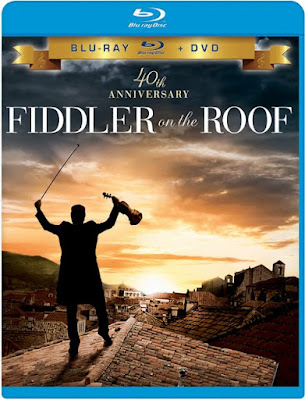After embracing “the new style” of love as opposed to the tradition of matchmaking over the course of Fiddler’s “happiness and tears” laden three hour running time, Tevye’s three eldest daughters approach their father – one “following another” – with the hope of wedding a man of their own choosing.
And Tevye’s onscreen struggle to evaluate old ways and new changes to find an ideal balance between his love for tradition and his love for his family was mirrored by director Norman Jewison offscreen in his structurally faithful yet cinematically daring 1971 big screen adaptation of the enormously popular Broadway musical based on Sholem Aleichem
Beginning with a controversial yet key casting decision to embrace change rather than give into expected tradition, Jewison decided to highlight the poignancy of the subject matter rather than play up the laughter by hiring an actor instead of a comedian, casting London’s leading man Topol in favor of Zero Mostel who had originated the role of Tevye on Broadway.
Set just after the turn of the century in the small Orthodox Jewish section of the Tsarist Russian village of Anatevka before the pogrom forced the Jews off the land, while the narrative stayed the same, the overall tone of Fiddler changed from stage to screen with Jewison's emphasis on historical realism over sentimental escapism.
And given Fiddler
Of course, without altering the script altogether and reworking Fiddler from a structural level to try and make the tonally bipolar picture flow more naturally, the repetitive story problems haven't been fixed.
Likewise, although Fiddler’s only moderately successful as an overly long and uneven production, it’d be interesting to reevaluate in the form of the ’79 rerelease cut, which omitted the songs “Far From the Home I Love” and “Anatevka,” which despite being beautiful on their own, were essentially dead-weight in the movie’s most frustratingly paced act.
While it’s definitely elevated by Topol in his Academy Award nominated role as the film’s anchor, Fiddler on the Roof
Once again blending old and new, Jewison encouraged his editors to continue experimenting with the same style of fast, rhythmic cuts that had won his old editor Hal Ashby an Oscar on In the Heat of the Night
And avoiding the lush panoramic beauty of The Sound of Music altogether, innovative Moulin Rouge
Fiddler makes its high definition debut with a newly remastered 7.1 DTS-HD master audio dynamic soundtrack that pours out of every single speaker in your home theater set-up yet nonetheless illustrates the shortcomings in a 5.1 configuration with low-level dialogue and booming music.
Just one in a bevy of bonus features, the gorgeously executed combo-pack lets you play matchmaker for yourself. The 40th Anniversary Edition includes roughly a dozen extras on the Blu-ray disc and also boats a commentary track with Jewison and Topol on its standard edition DVD disc, for those who haven’t quite abandoned the old DVD tradition to embrace the new Blu-ray style of movie love in high definition.
Text ©2011, Film Intuition, LLC; All Rights Reserved. http://www.filmintuition.com Unauthorized Reproduction or Publication Elsewhere is Strictly Prohibited and in violation of the Digital Millennium Copyright Act.
FTC Disclosure: Per standard professional practice, I received a review copy of this title in order to evaluate it for my readers, which had no impact whatsoever on whether or not it received a favorable or unfavorable critique.





.jpg)

















